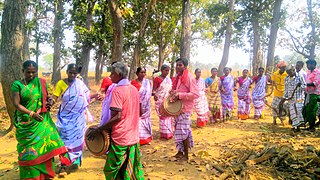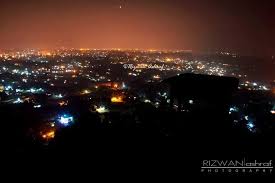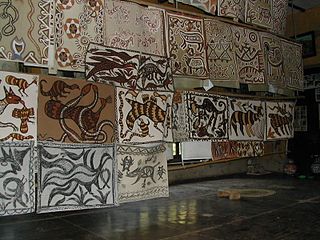
Jharkhand is a state in eastern India. The state shares its border with the states of West Bengal to the east, Chhattisgarh to the west, Uttar Pradesh to the northwest, Bihar to the north and Odisha to the south. It is the 15th largest state by area, and the 14th largest by population. Hindi is the official language of the state. The city of Ranchi is its capital and Dumka its sub-capital. The state is known for its waterfalls, hills and holy places; Baidyanath Dham, Parasnath, Dewri and Rajrappa are major religious sites. Jharkhand is primarily rural, with about 24% of its population living in cities as of 2011.

The Santal are an Austroasiatic-speaking Munda ethnic group of the Indian subcontinent. Santals are the largest tribe in the Jharkhand and West Bengal in terms of population and are also found in the states of Odisha, Bihar, Assam and Tripura. They are the largest ethnic minority in northern Bangladesh's Rajshahi Division and Rangpur Division. They have a sizeable population in Nepal. The Santals speak Santali, the most widely spoken Munda languages of Austroasiatic language family.

The Chota Nagpur Plateau is a plateau in eastern India, which covers much of Jharkhand state as well as adjacent parts of Chhattisgarh, Odisha, West Bengal and Bihar. The Indo-Gangetic plain lies to the north and east of the plateau, and the basin of the Mahanadi river lies to the south. The total area of the Chota Nagpur Plateau is approximately 65,000 square kilometres (25,000 sq mi).

Hazaribagh is a city and a municipal corporation in Hazaribagh district in the Indian state of Jharkhand. It is also the administrative headquarters of Hazaribagh district and divisional headquarters of North Chotanagpur division. It is known as a health resort and for the Hazaribagh Wildlife Sanctuary. It is represented in the Indian Lok Sabha by its Member of Parliament, Manish Jaiswal.
The tribes of Jharkhand consist of 32 scheduled tribes inhabiting the Jharkhand state in India. In 1872, only 18 tribes were counted among the scheduled tribes from which Banjara, Bhatudi, Chik Baraik, and Mahli were marked as semi-Hindu aboriginal and Kora as proletariat Hindu. In the 1931 census, including the above four semi-Hindu aboriginal and Kora, a proletariat Hindu, the number was raised to 26 from 18. They were Birajia, Godait, Karmali and Paharia, but Kisan was excluded from the list. In the 1941 census, Baga, Bedia and Lohra were included again taking Kisan in the annexure and the number came to 30 which prevailed till June 2003. Kanwar and Kol were added on 8 June 2003 in the annexure and the number of Schedule Tribes came to 32.

The Indian National Trust for Art and Cultural Heritage (INTACH) is a non-profit charitable organisation registered under the Societies Registration Act, 1860.
The Birhor language is a highly endangered Munda language spoken by the Birhor people in Chhattisgarh, Odisha, West Bengal, and Maharashtra states in India.

Dr. Haldhar Nag born 31 March 1950) is a Sambalpuri poet and writer from Bargarh, Odisha, India. Popularly known as "Lok Kabi Ratna", meaning "folk poet gem"). He was awarded Padma Shri, the fourth highest civilian award of India by Government of India in 2016.
Tourism in Jharkhand refers to tourism in the Indian state of Jharkhand. Jharkhand is known for its waterfalls, hills and holy places.
Ravindra Singh Bisht is an Indian archaeologist, known for his scholarship on Indus valley civilization and efforts to conserve Indian national monuments. He was honoured by the Government of India, in 2013, by bestowing on him the Padma Shri, the fourth highest civilian award, for his contributions to the field of archaeology.
Ranjit Bhargava, is an Indian environmentalist, known for his endeavors towards environmental conservation and his efforts for obtaining UNESCO World Heritage Site status for the upper Ganga region. The Government of India honored him in 2010, with the fourth highest civilian award of Padma Shri. He is also a recipient of the Order of the Golden Ark from Prince Bernard of the Netherlands and the Order of Merit of the Government of Germany.
Bal Krishen Thapar was an Indian archaeologist who served as the Director-general of the Archaeological Survey of India from 1978 to 1981. He was the founder of INTACH.

Laltluangliana Khiangte is a Mizo academic, playwright and poet of Mizo literature. He was the principal of the Serampore College and a former professor at Pachhunga University College and the North Eastern Hill University. He is presently serving as the senior most professor at the Department of Mizo at Mizoram University. He is a recipient of the Pu Buanga Award, the highest literary award of the Mizo Academy of Letters. The Government of India awarded him the fourth highest civilian honour of the Padma Shri, in 2006, for his contributions to Indian literature.

Sanskriti Museum & Art Gallery, Hazaribagh was founded by Bulu Imam in 1991, after he discovered the first rockart of Hazaribagh district at Isco, subsequently bringing to light over dozen meso-chalcolithic rockarts, including the prehistoric archaeology of the North Karanpura Valley in Jharkhand.
Barkagaon is a village in the Barkagaon CD block in the Hazaribagh Sadar subdivision of the Hazaribagh district in the Indian state of Jharkhand.
Gobardhan Panika is an Indian master weaver of Kotpad handloom a traditional tribal craft. The Government of India awarded him the fourth highest civilian honour of the Padma Shri, in 2018, for his contributions to the art of weaving.

Bhuri Bai is an Indian Bhil artist. She was born in Pitol village, situated on the border of Madhya Pradesh and Gujarat. Pitol is a village of Jhabua district in Madhya Pradesh. Bhuri Bai belongs to the community of Bhils, the largest tribal group of India. She has won many awards including the highest state honour accorded to artists by the Madhya Pradesh government, the Shikhar Samman. She was awarded India's fourth highest civilian award the Padma Shri in 2021.

Sohrai and Khovar are aboriginal methods of wall painting or mural prevalent in the eastern part of India, particularly in the Hazaribagh district of Jharkhand. The art is related to the festival of Sohrai which is celebrated during the autumn months after the Hindu festival of Diwali. Khovar painting specifically relates marriage rituals among the tribes in the region. It is celebrated after the monsoon season and at the start of the paddy harvest season.

The Tribal Women Artists Cooperative (TWAC) was initially founded by Bulu Imam in 1993 out of a Tribal Art Project funded by the Australian High Commission, New Delhi. The cooperative continues to be directed by Bulu Imam, Padma Shri awardee (2019) as a social worker for promoting the ritual Khovar and Sohrai mural painting tradition, benefiting thousands of village women, and has gained international recognition through several exhibitions in major art galleries around the world.

Godna, also known as Khoda, is an ancient traditional form of tattoo art originating from the tribal communities of Northern and Central India. These tattoos are characterized by intricate designs and vivid colors, often depicting elements of nature, mythology, and daily life.












